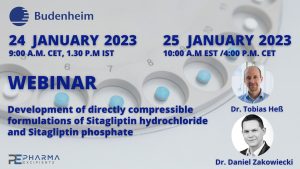Dissolvable microneedles for transdermal drug delivery showing skin pentation and modified drug release

Topical therapies for chronic skin diseases suffer from a low patient compliance due to the inconvenient treatment regimens of available products. Dissolvable microneedles (MN) with modified release offer an interesting possibility to increase the compliance by acting as a depot in the skin and thereby decreasing the dosing frequency. Furthermore, the bioavailability can be increased significantly by bypassing the barrier of the skin by the direct penetration of the MN into the skin. In this study the depot effect and skin penetration of an innovative dissolvable MN patch was assessed by insertion in ex vivo human skin and in vivo using minipigs.
The MN patches are based on biodegradable polymers and the active pharmaceutical ingredients calcipotriol (Calci) and betamethasone-17-21-dipropionate (BDP) used to treat psoriasis. Using computed tomography (CT) and coherent anti-Stokes Raman scattering (CARS) microscopy it was possible to visualize the skin penetration and follow the morphology of the MN as function of time in the skin. The depot effect was assessed by studying the modified in vitro release in an aqueous buffer and by comparing the drug release of a single application of a patch both ex vivo and in vivo to daily application of a marketed oleogel containing the same active pharmaceutical ingredients. The CT and CARS showed efficient penetration of the MN patches into the upper dermis and a slow swelling process of the drug containing tip over a period of 8 days.
Furthermore, CARS demonstrated that it can be used as a noninvasive technique with potential applicability in clinical settings. The in vitro release studies show a release of 54 % over a time period of 30 days. The pharmacological relevance of MNs was confirmed in human skin explants and in vivo after single application and showed a similar response on calcipotriol and BDP mediated signaling events compared to daily application of the active oleogel. Altogether it was demonstrated that the MN can penetrate the skin and have the potential to provide a depot effect.
Download the full article as PDF here Dissolvable microneedles for transdermal drug delivery showing skin pentation and modified drug release
or read it here
Materials
Each 500 µm long needle consists of a fast dissolving backing layer, polyvinylpyrrolidone, PVP, (Kollidon® 17 PF from BASF ChemTrade GmBH, Germany) and a slowly degrading tip layer, poly(lactic-co-glycolic acid), PLGA, (Resomer® RG502 from Evonik Nutrition & Care GmBH, Germany) in which the drugs are molecularly dispersed. The needle patches were made by casting the needles in a custom-made mould from RauMedic, Münchberg, Germany).
Irina Iachina, André H. Eriksson, Malene Bertelsen, Karsten Petersson, Jörgen Jansson, Pernille Kemp, Karen M. Engell, Jonathan R. Brewer, Kim T. Nielsen, Dissolvable microneedles for transdermal drug delivery showing skin pentation and modified drug release, European Journal of Pharmaceutical Sciences, 2023, 106371, ISSN 0928-0987, https://doi.org/10.1016/j.ejps.2023.106371.
Our next webinar:
For free registration and more information click on the picture below or here:


